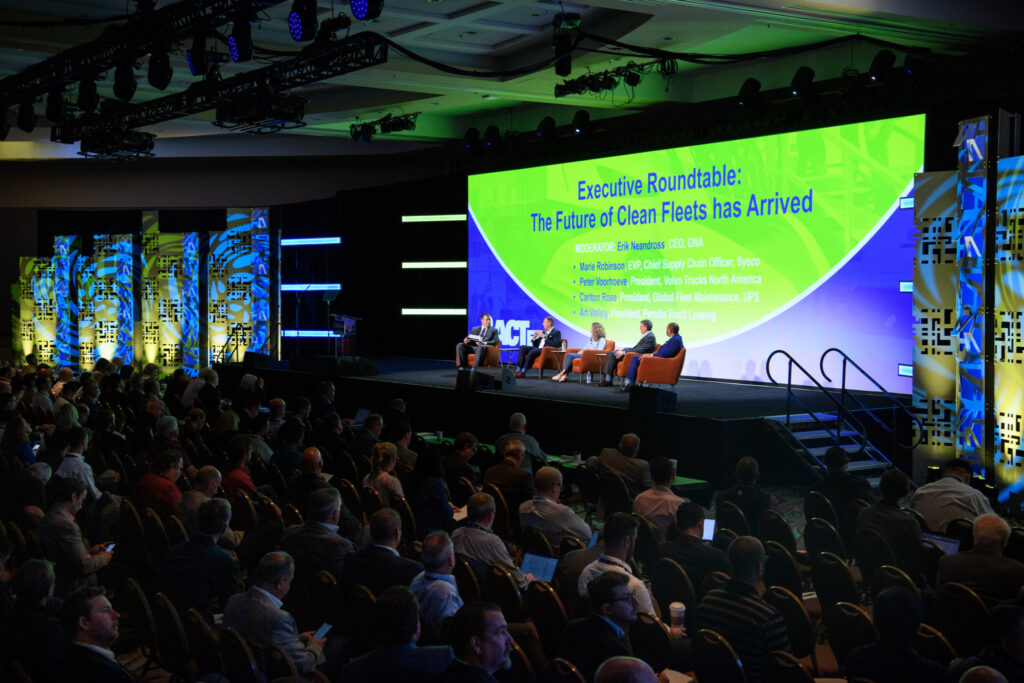Fleet executives call for collaboration in electric and alternative vehicle journey
Carlton Rose, president – global fleet maintenance at UPS, can rattle off a long list of alternative fuels and energy sources used by his fleet. Available equipment runs on compressed natural gas (CNG), liquefied natural gas (LNG), battery power, hybrid platforms, and propane. By 2025, 40% of his ground equipment will run on alternative energy sources.
And he insists the work supports more than his fleet alone.
“We just didn’t do it for UPS. We’ve done it for the industry,” he said during an executive roundtable at ACT Expo in Long Beach, California. Every purchase helps to establish the scale that lowers costs. The technology evolves as well. “This is a team effort throughout this industry.”

Still, Rose wondered why his fleet should need to pay a premium for the emerging technology – especially since early adopters serve as rolling labs for the equipment.
“The economics and the environment, at some point they have to intersect,” he said.
“When you do make it available, make it affordable.”
Art Vallely, president of Penske Truck Leasing, also stressed that operations with a handful of trucks can’t be forgotten in the journey to sustainability. Eighty percent of leasing customers have five trucks or less, he noted.
“That group of smaller customers are critical to us. They’re relying on us to test … as many vehicles as we can.”
The fleet has for 30 years been maintaining equipment that runs on alternative fuels. But there’s been a significant increase in the last two years, with deals for battery-electric vehicles including the Ford E-Transit, International eMV, Freightliner eCascadia, and Volvo VNR Electric.
For its part, Penske is also looking for partners to help accelerate the rollout of the all-important infrastructure to recharge the batteries. Forty percent of the Penske locations lined up to adopt the 750 E-Transits currently need to wait 18-36 months to get the charging stations.
“Getting that charging infrastructure to support the vehicles is going to be critical,” he said.
“The more of us that are working on these challenges together, the faster we’re going to get there,” said Marie Robinson, executive vice-president and chief supply chain officer at Sysco.
Her fleet wants to electrify 35% of its tractors by 2030, and is already working on the targets that will follow. Costs, reliability and performance will all improve over the next 20, 30 and 40 years, Robinson said. As the cost of diesel equipment becomes more expensive, the business cases relating to corporate social responsibility (CSR) statements will also improve.
Grids and grants
There are roles for public policymakers, too. A secure, stable and clean electric grid is part of that.
“We’d like there to be a smooth, welcoming onramp for the electric vehicles,” Robinson said, “and we’d like there to be a graceful offramp for the diesel vehicles.”
Erik Neandross, CEO of Gladstein, Neandross and Associates, has been tracking 500 different public programs in the U.S. and Canada. Together they will invest about US $20 billion a year, up from annual totals that were recently closer to $3 billion. “It’s a good, meaningful among of money to push into the system.”
There will be tightening regulations as well. The California Air Resources Board (CARB) is expected to adopt Advanced Clean Fleets rules this October, he said. That will require the state’s truck and bus fleets to generate zero emissions by 2045 everywhere it’s feasible.
Changes to California’s emissions standards to meet lower NOx levels could add US $40,000 to the cost of a heavy-duty diesel engine, though. “You’re going to see massive amounts of new aftertreatment on these engines,” he said. A national low-NOx standard could be in place by 2027.
“It’s going to be a wild next couple of years to be sure.”
Have your say
This is a moderated forum. Comments will no longer be published unless they are accompanied by a first and last name and a verifiable email address. (Today's Trucking will not publish or share the email address.) Profane language and content deemed to be libelous, racist, or threatening in nature will not be published under any circumstances.